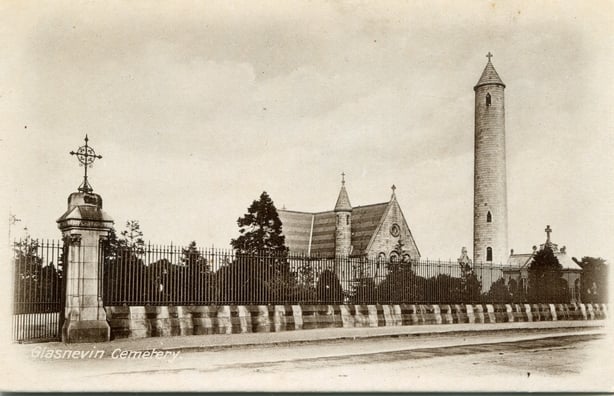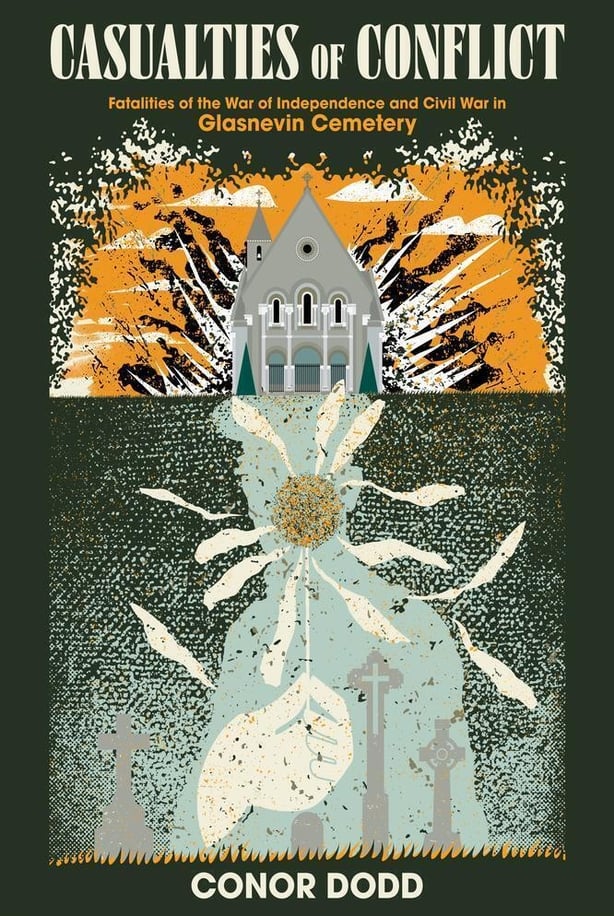To mark the conclusion of the Decade of Centenaries, recognising the significant events and tumultuous period of political change in Ireland between 1913 and 1923, a new book, Casualties of Conflict, explores the lives and deaths of over 300 men, women and children buried in Glasnevin Cemetery who died due to the War of Independence and Civil War.
Extracted from Casualties of Conflict, read four of their shortened biographies below.
John Byrne
On 25 May 1921 one of the most dramatic events during the War of Independence in Dublin was played out at the Custom House. On that day, a large contingent of over 100 members of Dublin Brigade IRA attacked and burned the building. It was targeted as one of the most obvious symbolic structures of British rule in Ireland and from it was directed a wide range of government services and departments including administrative elements of taxation in the country. The eventful attack was over in about an hour but the fire that had been set burned for several days.
In the aftermath of the fighting the task began of identifying and burying the dead. One of the bodies, an unknown man found at the scene, was brought to King George V Hospital. The man was identified as James Kelly, a labourer from Lower Gardiner Street, by his wife, Bridget Kelly. Having seen the body of her husband she confirmed that it was James making a formal statement on Friday 27 May 1921:
"I identify the body I have just seen as that of my husband James Kelly. He was 38 years old, he was a casual labourer. He never mentioned politics and had nothing at all to do with them as far as I know. He was out of work and looking for it when he met his death. He served in the Navy for a short period during the Great War. He was in the South African War and served 13 years in the Connaught Rangers."
Bridget made her way to Rutland (Parnell) Square and the offices of the Dublin Cemeteries Committee where she arranged for the burial of her husband. She then bought her mourning clothes and a shirt for him to be laid out in. The following day just before 13.00 in the afternoon Bridget received a letter signed by her husband, alive and under arrest in Arbour Hill Detention Barracks asking her to send him a pipe and some tobacco.
It transpired that James Kelly had been one of those rounded up in the aftermath of the Custom House fighting. Bridget quickly left for the police station to inform them of her mistake, lamenting the fact that the shirt she had bought for her resurrected husband was now on the body of an unknown man.
It was a short time before it was established that the unknown man was John Byrne, a twenty-seven-year-old poulterer from Killarney Street. He was identified by his sister Eileen who noted that he cycled past the Custom House four times each day on the way from his home to work and back. He was buried in Glasnevin on 2 June 1921.

Margaret Keogh
Margaret Keogh, from Stella Gardens in Ringsend, was fatally injured at her home on the evening of Saturday 9 July 1921. Born in 1900 she was the daughter of Margaret Mulvany and Michael Keogh. Her father was a baker from Dublin and her mother was from Swords, they had married in 1898. At the time of her death, Margaret was the second eldest of ten surviving children. She was employed as a clerical assistant in the Acme Works of the printers Hely & Co. at Dame Court. She was also a member of Cumann na mBan, a captain of the Croke camogie team and a member of the Irish Clerical Workers' Union. Newspaper reports described that on the evening of her death Margaret and her brother, Thomas, were the only members of the Keogh family awake at their home when there was a knock at the door. Margaret went to the door and was heard to shout out 'Mother, mother, I am shot’. Thomas Keogh ran to the door and carried his sister to the kitchen where he saw that she was wounded in the side. She was taken to Sir Patrick Dun’s Hospital where her condition initially improved before she lost consciousness and died at 04.00 on the morning of 12 July. Before dying, Margaret Keogh made a statement describing that she had opened the door but could not see anybody standing outside. As she went to close the door, she felt a sting in her side. She said she had no idea who fired the shot.
There was little light shed on the identity of a potential perpetrator. A neighbour noted that shortly before the shooting somebody had knocked on the door of the home of a man who was described as being ‘on the run’ but was stopped from entering. Her death appeared to bear similarities with the curfew shootings of Peter O’Carroll and William McGrath. However, a family account described the circumstances of her death in a very different manner to what was made public at the time. According to Margaret’s elder sister the home of the Keogh family was a store for IRA arms and ammunition. On the night that Margaret was wounded there was an attempt to move the weapons due to the fear of a potential raid. In the course of the move, a bullet that had fallen into a fire, exploded and its shrapnel hit Margaret. The attempt to keep this information from authorities and public knowledge proved successful. The funeral of Margaret Keogh came to Glasnevin on the morning of 14 July 1921. Her coffin was covered with a Tricolour and the cortege, which was large, attracted many onlookers and interested members of the public. The hearse was followed by members of Cumann na mBan, the GAA and work colleagues. She was buried in a grave in which her brother Patrick, who had died aged 1, was previously interred.

Frederick and Gerard McKenna
In August 1922, during the Civil War, the National Army began an offensive with the objective of capturing Cork city, which was under the control of the anti-Treaty IRA. Their plan to take the city involved amphibious landings, the largest of which, with 450 men, was to take place at Passage West, from where they intended to advance west.
Frederick McKenna was the elder of two teenage brothers who were killed during the landing at Passage West in 1922. Born in April 1904, he was eighteen at the time of his death. The son of Mary Jane McCullough and Alfred George McKenna, his father was a medical doctor and surgeon. Originally from Galway, Alfred McKenna studied at Edinburgh before moving to Belfast. It was there that Frederick and his younger brother Gerald were born, as well as two other siblings, an older brother and younger sister. During the First World War, their father had served as a captain in the Royal Army Medical Corps and their eldest brother Robert was a pilot in the Royal Air Force. The family remained in Belfast until after the end of the war and then moved to Phibsborough in Dublin.
While living there, Frederick and Gerald both enlisted in the National Army and were sent to Cork in August 1922. Their mother received a notification that her sixteen year-old son, Gerald, had been killed in action and on the day of his funeral to Glasnevin travelled to the mortuary at Portobello Barracks to view his body before the ceremony. While there she noticed another, unidentified, body and realised that it was her other son Fred. Both Mary Jane McKenna and her only surviving son, Robert, were described as being overcome with grief. Both brothers were buried in the National Army plot.
Casualties Of Conflict is published by Mercier Press

